Work energy and Power
(1) Introduction
- In our everyday life we use terms like work and enegy.
- Term work is generally used in context to any kind of activity requiring physical or mental effort.
- But this is not the way how we define work done in physics.
- When we push or pull a heavy load or lift it above the floor then we are doing work, but a man carrying heavy load and standing still is not doing any work according to scientific definiton of work.
- Another term we often use is energy. Energy is usually associated with work done in the sence that a person feeling very energetic is capable of doing lot of work.
- This way energy defined to be as capacity of doing work.
- There are many forms of energy like chemical energy, mechanical energy, electrical energy, heat energy etc. These forms of energies can be used in number of ways.
- One form of energy can be converted into another form of energy.
- In this chapter we will study about work, relation between work and energy, conservation of energy etc.
(2) Work
- We already know that work is said to be done when a force produces motion.
- Work done is defined in such a way that it involves both force applied on the body and the displacement of the body.
- Consider a block placed on a frictionless horizontal floor. This block is acted upon by a constant force F. Action of this force is to move the body through a distance d in a straight line in the direction of force.
- Now , work done by this force is equal to the product of the magnitude of applied force and the distance through which the body moves. Mathematically,
W=Fd (1)
where, F=|F| - Consider the figure given below
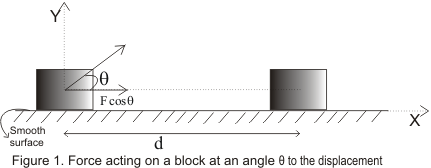
- In this case force acting on the block is constant but the direction of force and direction of displacement caused by this force is different. Here force F acts at an angle θ to the displacement d
- Effective component of force along the direction of displacement is Fcosθ and this component of force is responsible for the displacement of the block in the given direction.
- Thus , work done by the force F in in displacing the body thruugh displacement d is
W=(|F|cosθ)|d| (2)
In equation 2 work done is defined as the product of magnitude of displacement d and the component of force in the direction of displacement. - We know that the scalar product of two vectors A and B where A makes an angle θ with B is given by
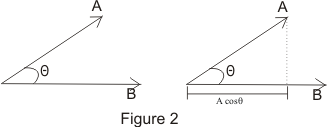
A.B=|A| |B|cosθ - Comparing equation 2 with definition of scalar products work done can be written as
W=F.d (3) - Now consider two special cases:-
(i) When angle θ=0 i.e., force is in the same direction as of displacement, then from equation (2)
W=|F| |d|
this is the same result as of equation 1
(ii) when angle θ=90 i.e., direction of force is perpandicular to that of displacement, then from equation (2)
W=(|F|cos90)|d|=0
that is force applies has no component along the displacement and hence force does not do any work on the body. - Work done by a force on a body can be positive, negative and zero i.e.,
(a) Work done is positive :- Force is in the same direction as displacement for example work done by force for pushing a block of mass m
(b) Work done is negative :- Force is opposite to the displacement for example when a body slides on horisontal surface work done by frictional forces on body is negative as frictional force always acts opposite to displacement of the body.
(c) Work done is zero :- Force is at rigt angle to the displacement for example work of a centripetal force on a body moving in a circle. - Unit of work done in any system of units is equal to the unit of force multiplied by the unit of distance. In SI system unit of work is 1Nm and is given a name Joule(J). Thus,
1J=1Nm
In CGS system unit is erg
1erg=1 dyne-cm
and 1 erg=10-7J - When more then one forces acts on a body then work done by each force should be calculated separately and added togather
(3) Work done by variable force
- So far we have defined work done by a force which is constant in both magnitude and direction.
- However, work can be done by forces that varies in magnitude and direction during the displacement of the body on which it acts.
- For simplicity consider the direction of force acting on the body to be along x-axis also consider the force F(x) is some known function of position x
- Now total displacement or path of the body can be decomposed into number of small intervals Δx such that with in each interval force F(x) can be considered to be approximately constant as shown below in the figure
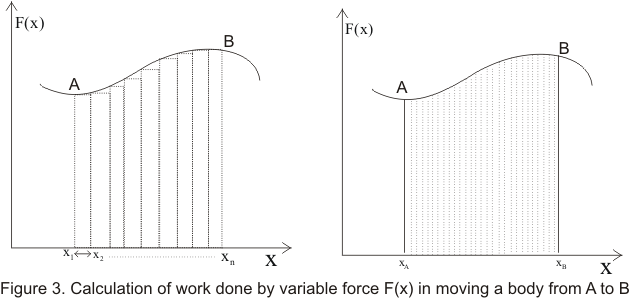
- Workdone in moving the body from x1 to x2 is given by
ΔW=F(x1)Δx1 where Δx1=x2-x1 - Total workdone in moving the body from point A to point B
W=F(x1)Δx1 +F(x2)Δx2 +F(x3)Δx3 .....+F(xn)Δxn
W=Σ F(xi)Δxi where i=1 to i=n (4)
Where Σ is the symbol of summation - Summation in equation 4 is equal to shaded area in figure 3(a) .More accuracy of results can be obtained by making these interval infintesimally smaller
- We get the exact value of workdone by making each interval so much small such that #916;x-> 0 which means curved path being decomposed into infinte number of line segment i.e
W= LimΔx-> 0Σ F(xi)Δxi (5)
W =∫ F(x)dx with in the limits xA and xB
Where ∫ F(x)dx is the intregal of F(x) w.r.t x between the limits xA and xB and intregal can be evaluated using methods of calculus if F(x) of x is known - Instead of x if the force also acts along y and z axis i.e direction of force keeps on changing then workdone bu such a force is given by
W=∫ F(r)dr with in the limits rA and rB (6)
Where F(r)=F(x)i +F(y)j+ F(z)k
and dr=dxi +dyj+ dzk
Here F(x),F(y) and F(z) are rectangular components of the force along x ,y and z axis .Similary dx,dy and dz are rectangular components of displacement along
x ,y and z axis
(4) Mechanical Energy
- we already have an idea that energy is associated closely with work and we have defined energy of a body as the capacity of the body to do work
- In dynamics body can do work either due to its motion ,due to its position or both due to its motion and position
- Ability of a body to do work due to its motion is called kinetic energy for example piston of a locomotive is capable of doing of work
- Ability of a body to do work due to its position or shape is called potential energy For example workdone by a body due to gravity above surface of earth
- Sum of kinetic energy and Potential energy of body is known as its mechanical energy
Thus
M.E=K.E+P.E
(5) Kinetic energy
- Kinetic energy is the energy possesed by the body by virtue of its motion
- Body moving with greater velocity would posses greater K.E in comparison of the body moving with slower velocity
- Consider a body of mass m moving under the influenece of constant force F.From newton's second law of motion
F=ma
Where a is the acceleration of the body - If due to this acceleration a,velocity of the body increases from v1 to v2 during the displacement d then from equation of motion with constant acceleration we have
v22 -v12=2ad or
a=v22 -v12/2d Using this acceleration in Newton's second law of motion
we have
F=m(v22 -v12)/2d
or
Fd=m(v22 -v12)/2
or
Fd=mv22/2 -mv12/2 (7)
We know that Fd is the workdone by the force F in moving body through distance d - In equation(7),quantity on the right hand side mv2/2 is called the kinetic energy of the body
Thus
K=mv2/2 - Finally we can define KE of the body as one half of the product of mass of the body and the square of its speed
- Thus we see that quantity (mv2/2) arises purely becuase of the motion of the body
- In equation 7 quantity
K2=mv22/2
is the final KE of the body and
K1=mv12/2
is the initial KE of the body .Thus equation 7 becomes
W=K2-K1=ΔK (9) - Where ΔK is the change in KE.Hence from equation (9) ,we see that workdone by a force on a body is equal to the change in kinetic energy of the body
- Kinetic energy like work is a scalar quantity
- Unit of KE is same as that of work i.e Joule
- If there are number of forces acting on a body then we can find the resultant force ,which is the vector sum of all the forces and then find the workdone on the body
- Again equation (9) is a generalized result relating change in KE of the object and the net workdone on it.This equation can be summerized as
Kf=Ki+W (10)
which says that kinetic energy after net workdone is equal to the KE before net work plus network done.Above statement is also known as work-kinetic energy theorem of particles - Work energy theorem holds for both positive and negative workdone.if the workdone is positive then final KE increases by amount of the work and if workdone is negative then final KE decreases by the amount of workdone
(6)Potential energy
- Potential energy is the energy stored in the body or a system by virtue of its position in field of force or by its configuration
- Force acting on a body or system can change its PE
- Few examples of bodies possesing PE are given below
i) Stretched or compressed coiled spring
ii) Water stored up at a height in the Dam possess PE
iii) Any object placed above the height H from the surface of the earth posses PE - Potential energy is denoted by letter U
- In next two topics we would discuss following two example of PE
i)PE of a body due to gravity above the surface of earth
ii) PE of the spring when it is compressed orr elongated by the application of some external force
(7) Gravitational PE near the surface of the earth
- All bodies fall towards the earth with a constant acceleration known as acceleration due to gravity
- Consider a body of mass m placed at height h above the surface of the earth
- Now the body begins to fall towards the surface of the earth and at any time t ,it is at height h' (h' < h) above the surface of the earth
- During the fall of the body towards the earth a constant force F=mg acts on the body where direction of force is towards the earth
- Workdone by the constant force of gravity is
W=F.d
W=mg(h-h')
W=mgh-mgh' -(12)
From equation (12) ,we can clearly see that workdone depends on tbe difference in height or position - So a potential energy or more accurately gravitational potential energy can be associated with the body such that
U=mgh
Where h is the height of the body from the refrence point - if
Ui=mgh Uf=mgh' or
W=Ui-Uf=-ΔU (13)
The potential energy is greater at height h and smaller at lower height h - We can choose any position of the object and fix it zero gravitational PE level.PE at height above this level would be mgh
- The position of zero PE is choosen according to the convenience of the problem and generally earth surface is choosen as position of zero PE
- One important point to note is that equation (13) is valid even for the case when object object of mass m is thrown vertically upwards from height h to h'( h' > h)
- Points to keep in mind
i) If the body of mass m is thrown upwards a height h above the zero refrence level then its PE increase by an amount mgh
ii) If the body of mass falls vertically downwards through a height h ,the PE of body decreases by the amount mgh
(8) Conversion of Gravitational PE to KE
- Consider a object of mass placed at height H above the surface of the earth
- By virtue of its position the object possess PE equal to mgH
- When this objects falls it begins to accelerate towards earth surface with acceleration equal to acceleration due to gravity g
- When object accelerates it gathers speed and hence gains kinetic energy at the expense of gravitational PE
- To Analyze this conversion of PE in KE consider the figure given below
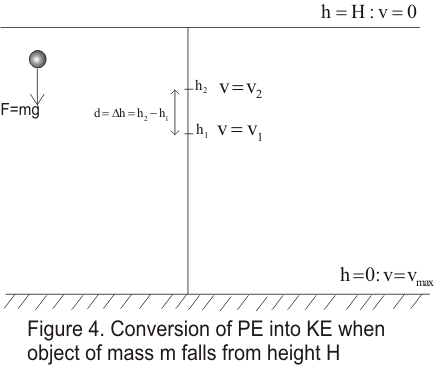
- Now at any given height h,PE of the object is given by the U=mgh and at this height speed of the object is given by v
- Change in KE between two height h1 and h2 would be equal to the workdone by the downward force
mv12/2 -mv22/2 =mgd (14)
Where d is the distance between two heights .here one important thing to note is that both force and are in the same downwards direction - Corresponding change in Potential energy
U1-U2=mg(h1-h2)=-mgd (15)
Here the negative sign indicates the decrease in PE whch is exacty equal to the gain in KE - From equation (14) and (15)
mv12/2 -mv22/2=U2-U1
or KE1 + PE1=KE2 + PE2 - Thus totat energy of the system KE and gravitational PE is conserved .There is a conversion of one form of energy into another during the motion but sum remains same
- This can be proved as follows
At height H,velocity of the object is zero
ie
at H=H ,v=0 => KE=0
So KE+PE=mgH
at H=h ,v=v => KE=mv2/2=mg(H-h) and U=mgh
So KE+PE==mgH
at H=0 ,v=vmax => KE=mvmax2/2=mgH
So KE+PE=mgH - This shows that total energy of the system is always conserved becuase total energy KE+PE=mgH ,which remains same as plotted in the figure given below
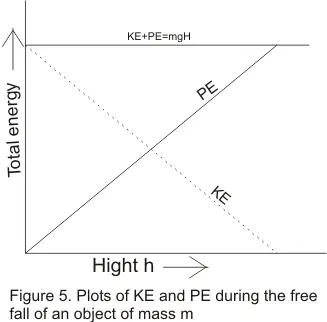
- We know conclude that energy can neither be produced nor be destroyed .It can only be transformed from one form to another
(9) PE of the spring
- To study this ,consider an electric spring of negligibly small mass .One end of the spring is attached to the rigid wall and another end of spring is attached to a block of mass m which can move on smooth frictionless horizozntal surface
- Consider the figure given below
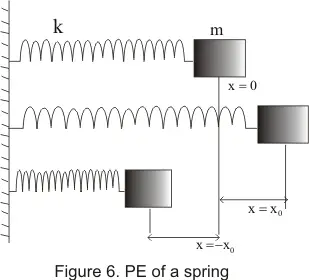
Here unstrectched or un compressed position of the spring is taken at x=0 - We now take the block from its unstrecthed position to a point P by stretching the spring
- At this point P restorinng force is exerted by the spring on the block trying it bring it back to the equlibrium position.
- Similar restoring force developes in the spring when we try to compress it
- For an ideal spring ,this restoring force F is proportional to displacement x and direction of restoring force is opposite to that displacement
- Thus force and displacement are related as
F α x
or F= - kx (16)
where K is called the spring constant and this equation (16) is known as Hook's law.negative sign indicates that force oppose the motion of the block along x - To stetch a spring we need to apply the external force which should be equal in magnitude and opposite to the direction of the restoring force mentioned above i.e for stretching the spring
Fext=Kx Similary for compressing the spring
- Fext= - Kx
or Fext=Kx (both F and x are being negative) - Workdone in both elongation and compression of spring is stored in the spring as its PE which can be easily calculated
- If the spring is stretched through a distance x from its equilibrium position x=0 then
W=∫Fextdx
Since both Fext and dx have same direction Now
W=∫Kxdx
On integrating with in the limits x=0 to x=x
We have
W=Kx2/2 (17) - This workdone is positive as force is towards the right and spring also moves towards the right
- Same amount of external is done on the spring when it is compressed through a distance x
- Workdone as calculated in equation (17) is stored as PE of the spring.Therefore
U=Kx2/2 (18)
(10)Conservation of energy of spring mass system
- Again consider the figure (6) where we have stretched the spring to a distance x0 from its equlibrium position x=0
- If we release the block then speed of the block begin to increase from zero and reach its maxmimum value at x=0 (equilbrium position)
- Assuming that there is no dissaption of energy due to air resistance and frictional forces ,whole of the PE is coverted in KE
- This means gain in KE is exactly equal to the loss in PE
- After reaching the equilbrium position at x=0 ,the block then crosses the equilibrium position ,it speed begin to decreass until it reaches the point x=-x0
- This would happen if whole the conversion between KE and PE is perfect without any dissipaton effect
- Now at x=-x0 PE of the block is maximum ,KE is zero and the restoring force again pulls the block towards its equilibrium position.This way block would keep on oscillating
- From all discussion ,we see that total mechanical energy (KE+PE) of the system always remain constant which is equal to Kx02/2
- We can analyze this as follows
x=x0 : v=0 : KE=0 : PE=Kx02/2 : TE=Kx02/2
x=x: v=v : KE=mv2/2=k(x02-x2)/2 : PE=Kx2/2 : TE=Kx02/2
x=0 : v=vmax: KE=mvmax2/2=Kx02/2 : PE=0 : TE=Kx02/2
x=-x0: v=0 : KE=0 : PE=Kx02/2 : TE=Kx02/2 - Graph of KE and PE are shown below in figure
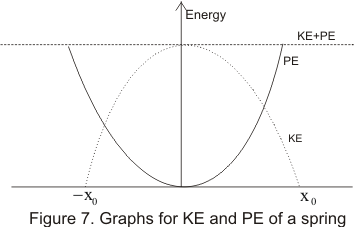
- From above graph we can easily conclude that when KE increases PE decreases and when PE increase KE decrease but total energy of the system remains constant
- Above discussed case is the ideal case when other dissipated forces like frictional forces or air resistance are assumed to be absent
- However in realty some part of the energy of the system is dissipated due to these resistive forces and after some time system looses all its energy and come to rest
(11) Conservative Forces
- Consider the gravitational force acting on a body .If we try to move this body upwards by applying a force on it then work is done against gravitation
- Consider a block of mass m being raised to height h vertically upwards as shown in fig 8(a) .Workdone in this case is mgh
- Now we make the block travel the path given in figure 8(b) to raise its height h above the ground.In this path workdone during the horizontal motion is zero because there is no change in height of the body due to which there would be no change in gravtitaional PE of the body and if there is no change in the speed KE would also remains same
- Thus for fig 8(b) if we add up the workdone in two vertical paths the result we get is equal to mgh
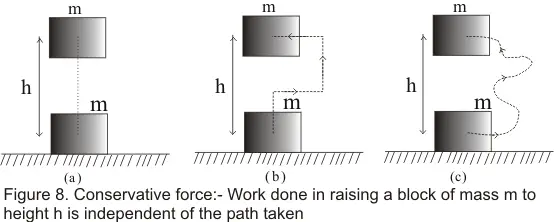
- Again if we move the the block to height h above the floor through an arbitary path as shown in fig 8(c) ,the workdone can be caluctlated by breaking the path into elementary horizontal and vertical portions
- Now workdone along the horizontal path would be zero and along the vertical paths its add up to mgh
- Thus we can say that workdone in raising on object against gravity is independent of the path taken and depends only on the intial and final position of the object
- Now we are in position to define the conservative forces
" If the workdone on particle by a force is independent of how particle moves and depends only on initial and final position of the objects then such a force is called conservative force"
Gravitatinal force,electrostatic force ,elastic force and magnetic forces are conservative forces - Total workdone by the conservative force is zero when particle moves around any closed path returning to its initial position
- Frictional forces and viscous forces are examples of non-conservative forces as these forces always oppose the motion and result in loss in KE
- Concept of PE is associated with conservative forces only .No such PE is associated with non-conservative forces like frictional forces
(12) Power
- Power is defined as rate of doing the work
- if ΔW amount of work is done in time interval Δt ,the instantanous power delivered will be
P=ΔW/Δt or P=dW/dt - For total workdone W in total time t,then average power
Pavg=W/t - If P does not vary with time ,then P=Pavg
- SI unit of power is joule/sec also called watt
- Another wunit of power is horsepower(hp)
1Hp=746watt
(13) Principle of conservation of energy
- We have already learned that KE+PE remains constant or conserved in absence of dissipative power
- As discussed in case of spring mass system in reality dissipative forces like friction and air resistance are always present and some of the energy of the system gets dissipated in the force of heat energy by increasing the internal energy of the spring
- This continues until system finally comes to rest
- If one can somehow measure this energy ,the sum of KE,PE and this internal (or energy dissipated) would remain constant .This can be extended to all types of energy
- Energy can not be created or destroyed .It can only be transferred from one form to another form.Total energy in a closed system always remains constant
- This is the law of conservation of energy although emprical one but it has never been found violated
Solved examples
Question 1. A body fall from height H.if t1 is time taken for covering first half height and
t2 be time taken for second half.Which of these relation is true for t1 and t2
a. t1 > t2
b. t1 < t2
c t1=t2
d Depends on the mass of the body
Solution 1.
Let H be the height
then
First Half
H/2=(1/2)gt12 ----(1)
or
(1/2)gt12=H/2
Also v=gt1
Second Half
H/2=vt2+(1/2)gt22
or
(H/2)=gt1t2+(1/2)gt22
or
(1/2)gt22 =(H/2)-gt1t2 ---(2)
From 1 and 2
(1/2)gt22=(1/2)gt12 -gt1t2
t22+2t1t2 -t12=0
or t2=[-2t1+√(4t1t2 +4t1t2 )]/2
or t2=[-2t1+2t1√8]/2
t2=.44t1
so t1 > t2
Hence a is correct
Question 2. Which of these is true of a conservative force?
a. Workdone between two points is independent of the path
b. Workdone in a closed loop is zero
c. if the workdone by the conservative is positive,its potential energy increases
d. None of the these
Solution 2. For a conservative force
Workdone between two points is independent of the path
Workdone in a closed loop is zero
And -W=Uf-Ui
So for positive work potential energy decreases
So a and b are correct
Question 3. A simple pendulum consists of a mass attached to a light string l. if the system is oscillating through small angles which of the following is true
a.The freqiency is independent of the acceleration due to gravity g
b.The period depends on the amplitude of the ocsillation
c.the period is independent of mass m
d. the period is independent of lenght l
Solution 3.Frequency =2π√(l/g)
So it is independent of the mass
Question 4. A body of mass m is dropped from a certain height.it has velocity v1 when it is at a height h1 above the ground.it has velocity v2 when it is at a height h2 above the ground.which of the following is true
a.v12-v22=2g(h1-h2)
b.v12-v22=2g(h2-h1)
c. v1-v2=√2g(√h2-√h1)
d. v1-v2=√2g(√h1-√h2)
Solution 4
Total Energy at height h1
=(1/2)mv12+2gh1
Total energy at height h2
=(1/2)mv22+2gh2
Since we know that total energy remains constant during a free fall
Total Energy at height h1=Total energy at height h2
or (1/2)mv12+2gh1=(1/2)mv22+2gh2
or v12-v22=2g(h2-h1)
Question 5.A pendulum has a length l.Its bob is pulled aside from its equilibrium position through any angle θ and then released.The speed of the bob when its passes through it equalibrium position
a.&radic:2gl
b. &radic:2gl(1-cosθ)
c.&radic:2glcosθ
d.&radic:2gl(1-sinθ
Solution 5 As shown in fgure,the height attained by the bob when the string subtends an angle θ is
h=l-lcosθ
or h=l(1-cosθ)
So potential energy at this point is given by
=mgh=mgl(1-cosθ)
When the bob passes through equilibrium position,this potential energy is converted into kinectic energy
if v be the velocity of the bob the KE=(1/2)mv2
Now (1/2)mv2=mgl(1-cosθ)
or v=radic:2gl(1-cosθ)
Question 6.A delivery boy wishes to launch a 2.0 kg package up an inclined plane with sufficent speed to reach the top of the incline.The plane is 3 mlong and is inclined at 20.Coefficent of friction between the package and the inclined plane is .40. what minimum intial KE must the boy suply to the package given as sin20=.342 cos20=.940
a 40 J
b. 42.2 J
c. 42.6 J
d. 45 J
Solution 6
The incline is shown in figure
If the package travels the entire length s of the incline ,the frictional force will perform work -μNs where μ is coefficient of friction and N is normal reaction.
Let h be the height of the incline plane then the gravtational potential energy of the package will increase by mgh.
Now let assume v speed be given to the package so as to reach the top
Then kinectic energy at the intial point=(1/2)mv2
Now applying work energy thoerm
K.Ef-K.Ei=Workdone by the gravitational force + workdone done by the frictional force
Now since K.Ef=0
Also Workdone by the gravitational force=-(change in gravitational potential energy)=-mgh
Therefore
-(1/2)mv2=-mgh-μNs
or (1/2)mv2=mgh+μNs
Now s=3
N=mgcosθ
h=ssinθ
Substituting all the values
(1/2)mv2=42.2J
Question 7.Chosse the correct option
a.if Workdone by the conservative force is positive then Potential energy decreases
b. Rate of change of momentum of many particles system is proportional to net external force on the system
c.The workdone by the conservative force in closed loop is zero
d. None of the above
Solution 7-
The workdone by a conservative force is equal to the negative of the potential energy.When the wokdone is positive ,the potential energy decreases.
The rate of change of total momentum of a many -particle system is proportional to the net force external to the system ;the internal forces between particles cannot change the momentum of the system.The workdone by the conservative system is zero in closed loop
Hence a,b,c are correct
Question 8.The potential energy of a certain particle is given by
U=20x2+35z3.Find the vector force on it
a. -40xi-105z2k
b. 40xi-105z2k
c.-10xi-105z2k
d 40xi+105z2k
Solution 8.
U=20x2+35z3
F=-(∂/∂x)i--(∂/∂y)j--(∂/∂z)k
or
F=-40xi-105z2k
Matrix Match type
Question 9.
Column I
a. Frictional force
b. Gravitational force
c. Electrical force
d Viscous force
Column II
P. Workdone by the force in closed loop is zero
Q. Workdone by the force in closed loop is not zero
Solution 9
Frictional force is non conservative force
Gravitational force is conservative force
Electrical force is conservative force
Viscous force is non conservative force
And for conservative force, Workdone by the force in closed loop is zero
And for non conservative force,Workdone by the force in closed loop is not zero
Question 10.Which of the following is noninertial frame of refrence
a. A train which speeding Up
b. A train with constant speed
c. A train which speeding down
d A train at rest
Question 11.what is of these is true for Projectile motion
a. Velcoity is perpendicular to acceleration at the highest point
b. Horizontal components of velocity remains constant through out the path
c. Range of the projectile is given by Horizontal component of velocity X Time of flight
d. None of the above
Question 12. A block of mass M is pulled along a horizontal friction surface by a rope of mass m. If a force P is applied at the free end of the rope, the force exerted by the rope on the block is
a)Pm/m+M
b)P
c)PM/m+M
d)Pm/M-m
Question 13.A spring balance is attached to the ceiling of a lift. A man hangs his bag on the spring and the spring reads 49 N, when the lift is stationary. If the lift moves downward with an acceleration of 5 m/s2, the reading of the spring balance will be
(A) 24 N
(B) 74 N
(C) 15 N
(D) 49 N
Question 14. A particle moves in a straight line according to
x=t3-4t2+3t
Find the acceleration of the particle at displacement equal to zero
a.(-8,-2,10)
b. (-1,-2,10)
c. (8,2,10)
d. (1,2,10)
Question 14.Which of the following does not have unit as Joule?
a) Workdone
b) Kinetic Energy
c) Potential Energy
d) Force
Solution 14
Workdone Unit is joule
KE and PE also unit is Joule
Force Unit is Newton
So Solution (d)
Match the coloum
Question 15
Column A ( Physical quantity)
P)KE
Q)Potential Energy
R)Momentum
S)Mechanical Energy
Column B ( quantities it depends on)
A)Mass
B)Velocity
C)Position of the object
D)Volume
Solution 15
KE=.5mv2
PE=mgh
Momentum=mv
Mechanical Energy= KE +PE
P -> A,B
Q-> A,C
R-> A,B
S-> A,B.C
Question 16A truck driver pushes the acceleration peddle and increase it speed from v to 2v on the level Road. The mass of the Truck is M. Which of the following is true
a) PE of the truck does not change b) Final KE of the truck is 2Mv2
c) Workdone by the acceleration peddle is 1.5Mv2
d)PE of the truck becomes four times of the initial Potential energy Solution : Since it is running on level road. PE does not change Initial KE =.5Mv2
Final KE=2Mv2 Workdone by the acceleration peddle= Final KE – Initial KE=1.5Mv2
Question 1. A body fall from height H.if t1 is time taken for covering first half height and
t2 be time taken for second half.Which of these relation is true for t1 and t2
a. t1 > t2
b. t1 < t2
c t1=t2
d Depends on the mass of the body
Solution 1.
Let H be the height
then
First Half
H/2=(1/2)gt12 ----(1)
or
(1/2)gt12=H/2
Also v=gt1
Second Half
H/2=vt2+(1/2)gt22
or
(H/2)=gt1t2+(1/2)gt22
or
(1/2)gt22 =(H/2)-gt1t2 ---(2)
From 1 and 2
(1/2)gt22=(1/2)gt12 -gt1t2
t22+2t1t2 -t12=0
or t2=[-2t1+√(4t1t2 +4t1t2 )]/2
or t2=[-2t1+2t1√8]/2
t2=.44t1
so t1 > t2
Hence a is correct
Question 2. Which of these is true of a conservative force?
a. Workdone between two points is independent of the path
b. Workdone in a closed loop is zero
c. if the workdone by the conservative is positive,its potential energy increases
d. None of the these
Solution 2. For a conservative force
Workdone between two points is independent of the path
Workdone in a closed loop is zero
And -W=Uf-Ui
So for positive work potential energy decreases
So a and b are correct
Question 3. A simple pendulum consists of a mass attached to a light string l. if the system is oscillating through small angles which of the following is true
a.The freqiency is independent of the acceleration due to gravity g
b.The period depends on the amplitude of the ocsillation
c.the period is independent of mass m
d. the period is independent of lenght l
Solution 3.Frequency =2π√(l/g)
So it is independent of the mass
Question 4. A body of mass m is dropped from a certain height.it has velocity v1 when it is at a height h1 above the ground.it has velocity v2 when it is at a height h2 above the ground.which of the following is true
a.v12-v22=2g(h1-h2)
b.v12-v22=2g(h2-h1)
c. v1-v2=√2g(√h2-√h1)
d. v1-v2=√2g(√h1-√h2)
Solution 4
Total Energy at height h1
=(1/2)mv12+2gh1
Total energy at height h2
=(1/2)mv22+2gh2
Since we know that total energy remains constant during a free fall
Total Energy at height h1=Total energy at height h2
or (1/2)mv12+2gh1=(1/2)mv22+2gh2
or v12-v22=2g(h2-h1)
Question 5.A pendulum has a length l.Its bob is pulled aside from its equilibrium position through any angle θ and then released.The speed of the bob when its passes through it equalibrium position
a.&radic:2gl
b. &radic:2gl(1-cosθ)
c.&radic:2glcosθ
d.&radic:2gl(1-sinθ
Solution 5 As shown in fgure,the height attained by the bob when the string subtends an angle θ is
h=l-lcosθ
or h=l(1-cosθ)
So potential energy at this point is given by
=mgh=mgl(1-cosθ)
When the bob passes through equilibrium position,this potential energy is converted into kinectic energy
if v be the velocity of the bob the KE=(1/2)mv2
Now (1/2)mv2=mgl(1-cosθ)
or v=radic:2gl(1-cosθ)
Question 6.A delivery boy wishes to launch a 2.0 kg package up an inclined plane with sufficent speed to reach the top of the incline.The plane is 3 mlong and is inclined at 20.Coefficent of friction between the package and the inclined plane is .40. what minimum intial KE must the boy suply to the package given as sin20=.342 cos20=.940
a 40 J
b. 42.2 J
c. 42.6 J
d. 45 J
Solution 6
The incline is shown in figure
If the package travels the entire length s of the incline ,the frictional force will perform work -μNs where μ is coefficient of friction and N is normal reaction.
Let h be the height of the incline plane then the gravtational potential energy of the package will increase by mgh.
Now let assume v speed be given to the package so as to reach the top
Then kinectic energy at the intial point=(1/2)mv2
Now applying work energy thoerm
K.Ef-K.Ei=Workdone by the gravitational force + workdone done by the frictional force
Now since K.Ef=0
Also Workdone by the gravitational force=-(change in gravitational potential energy)=-mgh
Therefore
-(1/2)mv2=-mgh-μNs
or (1/2)mv2=mgh+μNs
Now s=3
N=mgcosθ
h=ssinθ
Substituting all the values
(1/2)mv2=42.2J
Question 7.Chosse the correct option
a.if Workdone by the conservative force is positive then Potential energy decreases
b. Rate of change of momentum of many particles system is proportional to net external force on the system
c.The workdone by the conservative force in closed loop is zero
d. None of the above
Solution 7-
The workdone by a conservative force is equal to the negative of the potential energy.When the wokdone is positive ,the potential energy decreases.
The rate of change of total momentum of a many -particle system is proportional to the net force external to the system ;the internal forces between particles cannot change the momentum of the system.The workdone by the conservative system is zero in closed loop
Hence a,b,c are correct
Question 8.The potential energy of a certain particle is given by
U=20x2+35z3.Find the vector force on it
a. -40xi-105z2k
b. 40xi-105z2k
c.-10xi-105z2k
d 40xi+105z2k
Solution 8.
U=20x2+35z3
F=-(∂/∂x)i--(∂/∂y)j--(∂/∂z)k
or
F=-40xi-105z2k
Matrix Match type
Question 9.
Column I
a. Frictional force
b. Gravitational force
c. Electrical force
d Viscous force
Column II
P. Workdone by the force in closed loop is zero
Q. Workdone by the force in closed loop is not zero
Solution 9
Frictional force is non conservative force
Gravitational force is conservative force
Electrical force is conservative force
Viscous force is non conservative force
And for conservative force, Workdone by the force in closed loop is zero
And for non conservative force,Workdone by the force in closed loop is not zero
Question 10.Which of the following is noninertial frame of refrence
a. A train which speeding Up
b. A train with constant speed
c. A train which speeding down
d A train at rest
Question 11.what is of these is true for Projectile motion
a. Velcoity is perpendicular to acceleration at the highest point
b. Horizontal components of velocity remains constant through out the path
c. Range of the projectile is given by Horizontal component of velocity X Time of flight
d. None of the above
Question 12. A block of mass M is pulled along a horizontal friction surface by a rope of mass m. If a force P is applied at the free end of the rope, the force exerted by the rope on the block is
a)Pm/m+M
b)P
c)PM/m+M
d)Pm/M-m
Question 13.A spring balance is attached to the ceiling of a lift. A man hangs his bag on the spring and the spring reads 49 N, when the lift is stationary. If the lift moves downward with an acceleration of 5 m/s2, the reading of the spring balance will be
(A) 24 N
(B) 74 N
(C) 15 N
(D) 49 N
Question 14. A particle moves in a straight line according to
x=t3-4t2+3t
Find the acceleration of the particle at displacement equal to zero
a.(-8,-2,10)
b. (-1,-2,10)
c. (8,2,10)
d. (1,2,10)
Question 14.Which of the following does not have unit as Joule?
a) Workdone
b) Kinetic Energy
c) Potential Energy
d) Force
Solution 14
Workdone Unit is joule
KE and PE also unit is Joule
Force Unit is Newton
So Solution (d)
Match the coloum
Question 15
Column A ( Physical quantity)
P)KE
Q)Potential Energy
R)Momentum
S)Mechanical Energy
Column B ( quantities it depends on)
A)Mass
B)Velocity
C)Position of the object
D)Volume
Solution 15
KE=.5mv2
PE=mgh
Momentum=mv
Mechanical Energy= KE +PE
P -> A,B
Q-> A,C
R-> A,B
S-> A,B.C
Question 16A truck driver pushes the acceleration peddle and increase it speed from v to 2v on the level Road. The mass of the Truck is M. Which of the following is true
a) PE of the truck does not change b) Final KE of the truck is 2Mv2
c) Workdone by the acceleration peddle is 1.5Mv2
d)PE of the truck becomes four times of the initial Potential energy Solution : Since it is running on level road. PE does not change Initial KE =.5Mv2
Final KE=2Mv2 Workdone by the acceleration peddle= Final KE – Initial KE=1.5Mv2

No comments:
Post a Comment